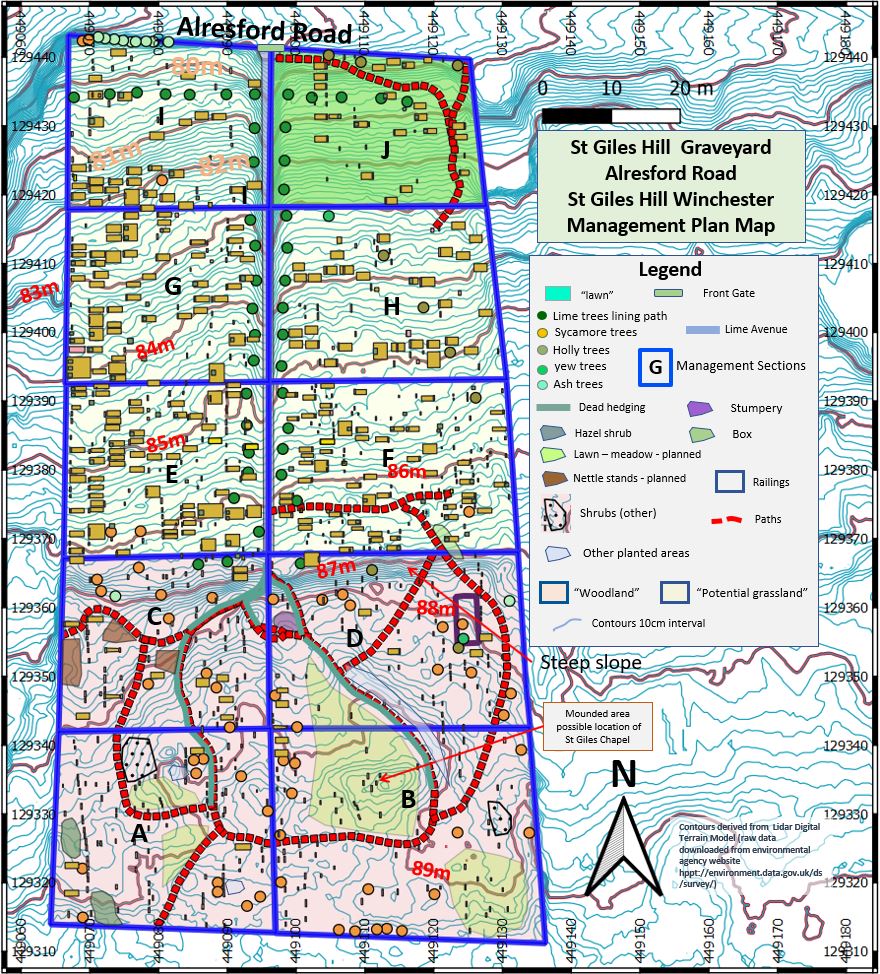The main objectives of the Friends of St Giles Hill Graveyard are to preserve and protect the social and historic importance of the graveyard, upholding its original purpose as place of reflection and remembrance of the people buried there, and to conserve is value as wildlife haven.
Management Plan
A detailed management plan has been compiled based on the above principles. The plan has been reviewed by several parties including the Winchester City Council diversity officer and the City archaeologist. Our plan consists of two strands; one to preserve the historic heritage and the other to preserve and develop wildlife habitats.
Currently, we do not have the financial resources to undertake any of the major work referred to in the plan. When money or other resources are available the land owners (The church of England) need to approve each piece of work.
It is hoped the site can be managed as a contribution to the Winchester local biodiversity action plan published some time ago in 2005. This plan envisages a linked network of open spaces along which wildlife can migrate. The graveyard lies between Magdalen Hill Down (Butterfly Conservation), , Winnall Moors, St Catherines Hill (Hampshire & Isle of Wight Nature Trust) and the adjoining St Giles Hill in this network. We have modeled the management plan on a similar footing to the Southampton Old Cemetery and the Green Flag winning Eastleigh Cemetery.
From the historic point of view, the site can be divided into two parts, here called the old and new graveyards. The old graveyard occupies the southern half of the site. It was first mentioned in association with the medieval St Giles Chapel in 1092. On Eighteenth Century maps the northern end of the site is shown as an open area of chalk hillside, possibly used as pasture. The graveyard was originally flanked on the northern side by Crok Lane. By the time the new graveyard can into operation around 1880 this lane had become disused.
The graveyard has been divided into sections to aid management. They are shown on the map below.


Sections A to D represent the “old” or “Medieval” Graveyard. It has been a churchyard since the 12C. The visible graves in this area are sparsely spaced. These sections will have lighter touch maintenance and be the part of the graveyard in which wildlife areas will be encouraged. At present the oldest part of the graveyard is occupied by veteran broad-leaved trees, comprising self-seeded sycamore, holly and Ash.
Section E to I form the remainder of the “New” graveyard (first utilized in the early 1800’s), which has all of the historic WW1 graves. The last know burial here was in 1973, and some people still visit graves. The gravestones are closely spaced and the vegetation will need periodic cutting throughout the year by hand or strimmer. The gravestones will need to be cleaned very carefully, so as not to damage the remaining inscriptions, especially when removing Ivy.
The more ambitious plans for the graveyard are the most costly. They include the construction and maintenance of paths around the old graveyard and WW1 graves, stabilising any potentially dangerous monuments, and the rebuilding of decayed flint walls.
In the old part of the graveyard tree management is planned for the development of “wildlife areas”. They are areas where shrub such as Hazel and Wild Privet are already present. The purpose of these areas is to develop the essential under and middle storey of vegetation so important to wildlife but currently missing from the graveyard. Additional plantings of native shrub species will be made.
- Remove trees from perimeter walls: Tree removal will be primarily from the perimeter walls, but only as a last resort. A priority area is the line of Ash trees that hang over the Alresford Rd on the north boundary. This may be especially important with the advance of Ash dieback disease in Hampshire. Trees that are causing damage to the perimeter wall at other locations will be cut back and removed in exceptional circumstances. Removal of trees is to be compensated with the planting of native shrubs. All work on trees must be carried out by a qualified tree surgeon and the relevant permits need to be acquired from Winchester City Council and the Church that own the property.
- Biomass management: Dead wood shall be retained and used to furnish material for paths, and natural fencing or as habitat piles to provide for biodiversity within the woodland, especially invertebrate habitat. Burning to remove waste is not allowed on this site.
View the latest management plan document.
 Loading...
Loading...
BACK GROUND TO MANAGMENT PLAN:
The management plan was built based on advice and guidelines laid out by several organizations including, English Heritage, Historic England, The War Memorials Trust, and a number of wildlife trusts. The following are some key documents from these organizations used to formulate our management philosophy:
Historic England published the following article: Caring for Historic Cemetery and graveyards Monuments (pub 2011).
English Heritage offer advice on Gardens and Landscapes Conservation. They publish Landscape Advice (LAN) Notes on a wide range of subjects. Some of these are mentioned below with links to the articles:-
The War memorials trust publishes extensive advice on historic graveyard management detailed in their frequently asked questions section.
Including the document:- Conservation Principles
CABE, Cemeteries, Churchyards and Burial Grounds briefing Cemeteries, churchyards and burial grounds. (2007).
Archaeology Scotland supplies an extensive range of documents for download from their website dealing with graveyard conservation and management, including gravestone care and repair.
Heritage Lottery Fund publish a guide to help applicants for grants such as Nature and Landscapes Guidance (pub Oct 2012):
Suffolk Wildlife Thrust: Offers extensive advice on churchyard management including Ivy management.

